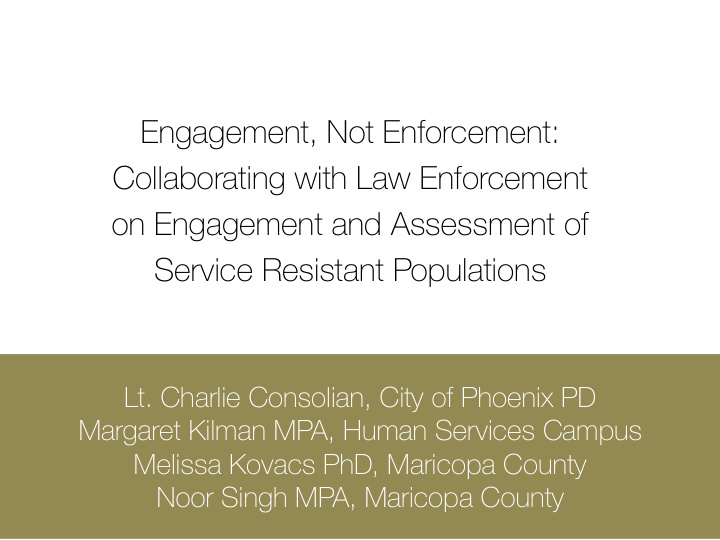



Engagement, Not Enforcement: Collaborating with Law Enforcement on Engagement and Assessment of Service Resistant Populations ¡ Lt. Charlie Consolian, City of Phoenix PD � Margaret Kilman MPA, Human Services Campus � Melissa Kovacs PhD, Maricopa County � Noor Singh MPA, Maricopa County
History • The Human Services Campus opened in 2005 • Primary partner agencies: Central Arizona Shelter Services (CASS), Lodestar Day Resource Center (LDRC), Maricopa County Healthcare for the Homeless, St. Joseph the Worker, St. Vincent de Paul, Terros/Safe Haven • Mission: Using the Power of Collaboration to Create Solutions to End Homelessness
Human Services Campus • More than 15 agencies on site – “one stop shop” for single adults experiencing homelessness • Services include ID/Birth Certificates (Homeless ID Project), Outreach and behavioral health (Southwest Behavioral Health), EMT and access to substance use/abuse treatment (Community Bridges, Inc.) • More than 1,000 individuals access services on the Campus each day
Coordinated Access/Assessment • Regional Coordinated Access/Assessment Center for single adults • More than 5,500 assessments conducted (VI-SPDAT) • Prioritization of resources
Engagement not Enforcement • Can’t arrest our way of homelessness • Ending homelessness through housing and services connection • Collaborating with services providers to engage folks rather than criminalize the homeless experience • Accountability
Collaboration • Misdemeanor Repeat O ff ender Program (MROP) • Security Operations Team (bi-monthly) – Identify frequent engagers with PD • All o ffi cers have received Assertive Engagement and VI-SPDAT training through the Human Services Campus • Case conferencing and open communication
Prioritization • Acuity based on VI-SPDAT score • Medical or mental health issues • Overall vulnerability • VI-SPDAT score prioritizes for housing interventions, navigation, and case management
Accomplishments • 39 assessments conducted since July 2014 highest score 15 lowest score 8 mean, median, mode = 11 • 4% decrease in overall crime (2012 – 2013) 3% decrease in property crime / 4% decrease in violent crime • 15% (6) of clients assessed by PD have had positive housing outcomes
Intersec(on ¡of ¡Jail ¡Usage, ¡Homelessness, ¡& ¡Mental ¡ Health ¡– ¡Maricopa ¡County, ¡AZ ¡ 7.8% ¡of ¡all ¡Jail ¡bookings ¡ 20.6% ¡of ¡all ¡Jail ¡ in ¡Maricopa ¡County ¡are ¡ Bookings ¡were ¡for ¡self ¡ for ¡Homeless ¡SMI ¡ reported ¡Homeless ¡ individuals ¡ ¡ individuals ¡ 7.8% ¡ 15.3% ¡ of ¡U.S. ¡jail ¡ populaAon ¡is ¡made ¡up ¡ of ¡homeless ¡inmates ¡ (Greenberg ¡et ¡al, ¡ 2008) ¡ Homelessness ¡is ¡measured ¡as ¡those ¡who ¡reported ¡an ¡episode ¡of ¡homelessness ¡currently ¡or ¡at ¡any ¡point ¡in ¡the ¡last ¡12 ¡months. ¡ ¡ ¡ In ¡Arizona, ¡the ¡state ¡Department ¡of ¡Behavioral ¡Health ¡Services ¡denotes ¡individuals ¡as ¡SMI, ¡and ¡we ¡and ¡Maricopa ¡County ¡jails ¡follow ¡ their ¡classifica(on. ¡ ¡ ¡
Gender ¡Breakdown ¡of ¡Homeless ¡and ¡ SMI ¡Individuals ¡in ¡Jails ¡ ¡ Percentage ¡of ¡Homeless ¡& ¡Homeless ¡SMI ¡in ¡Jails ¡ 22% ¡ 23% ¡ 32% ¡ 78% ¡ 77% ¡ 68% ¡ Homeless ¡ Homeless ¡SMI ¡ General ¡Jail ¡Popula(on ¡ Male ¡ Female ¡ General ¡Jail ¡Popula(on ¡is ¡defined ¡as ¡Non-‑SMI ¡individuals ¡with ¡no ¡self ¡reported ¡episode ¡of ¡homelessness ¡currently ¡or ¡in ¡the ¡last ¡ 12 ¡months ¡in ¡Maricopa ¡County. ¡ ¡ ¡
Median ¡Length ¡of ¡Stay ¡(LOS) ¡Analysis ¡ Homeless ¡and ¡Homeless ¡ SMI ¡individuals ¡stay ¡3 ¡ DAYS ¡LONGER ¡in ¡ Maricopa ¡County ¡Jails ¡ than ¡General ¡Jail ¡ Popula(on. ¡
Frequency ¡of ¡Jail ¡Usage ¡
Volume ¡Analysis ¡of ¡Maricopa ¡County ¡ Jails ¡(6 ¡Months) ¡
Most ¡Common ¡Charges ¡ 5 ¡Most ¡Common ¡Charges ¡for ¡ 5 ¡Most ¡Common ¡Charges ¡for ¡ Homeless ¡ Homeless ¡SMI ¡ ¡ ¡ Ø ProbaAon ¡ViolaAon ¡– ¡10% ¡ ¡ Ø ProbaAon ¡ViolaAon ¡-‑ ¡13% ¡ Ø Criminal ¡Trespassing ¡3 rd ¡Degree/ Ø Dangerous ¡Drug ¡Possession/Use ¡-‑ ¡ Property ¡– ¡5.6% ¡ 8% ¡ Ø Failure ¡To ¡Appear ¡2 nd ¡Degree ¡– ¡ Ø Drug ¡Paraphernalia-‑Possession/ 5% ¡ Use ¡– ¡5% ¡ Ø Dangerous ¡Drug-‑Possession/Use ¡ Ø Failure ¡To ¡Appear ¡2 nd ¡Degree ¡– ¡ – ¡5% ¡ 5% ¡ Ø Disorderly ¡Conduct-‑FighAng ¡– ¡4% ¡ Ø NarcoAc ¡Drug ¡– ¡Possession/Use ¡– ¡ 3% ¡
Community Engagement • Monthly community meetings • Creating sustainable community for stakeholders • Participatory feedback opportunities for residents, business owners, and person’s experiencing homelessness (forums, focus groups, grievance process)
Goals • To increase outreach and service connection – particularly for individuals not accessing resources on the Campus • Develop stronger collaborative relationships between service providers and PD • Maintain safe neighborhoods and reduction in crime
Challenges • Defining roles and responsibilities • Exploring outreach opportunities • O ffi cer buy-in • Cultural di ff erences between PD and services providers • Competing priorities • Accountability
Next Steps • Continued training • Developing clear processes for assessment • Examining new models of PD involvement in ending homelessness initiatives • Expanding partnerships with services providers
Questions?
Contact Lt. Charles Consolian charles.consolian@phoenix.gov Margaret Kilman mkilman@hsc-az.org Melissa Kovacs kovacsm@mail.maricopa.gov Noor Sing singn@mail.maricopa.gov
Recommend
More recommend